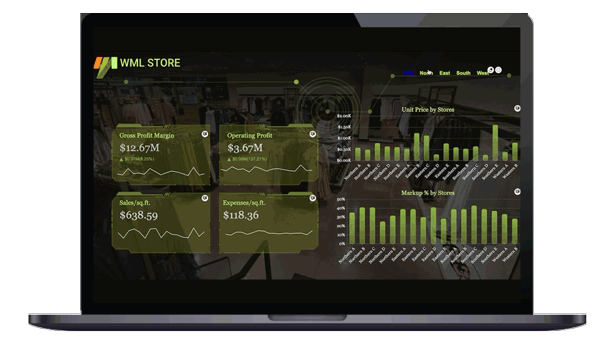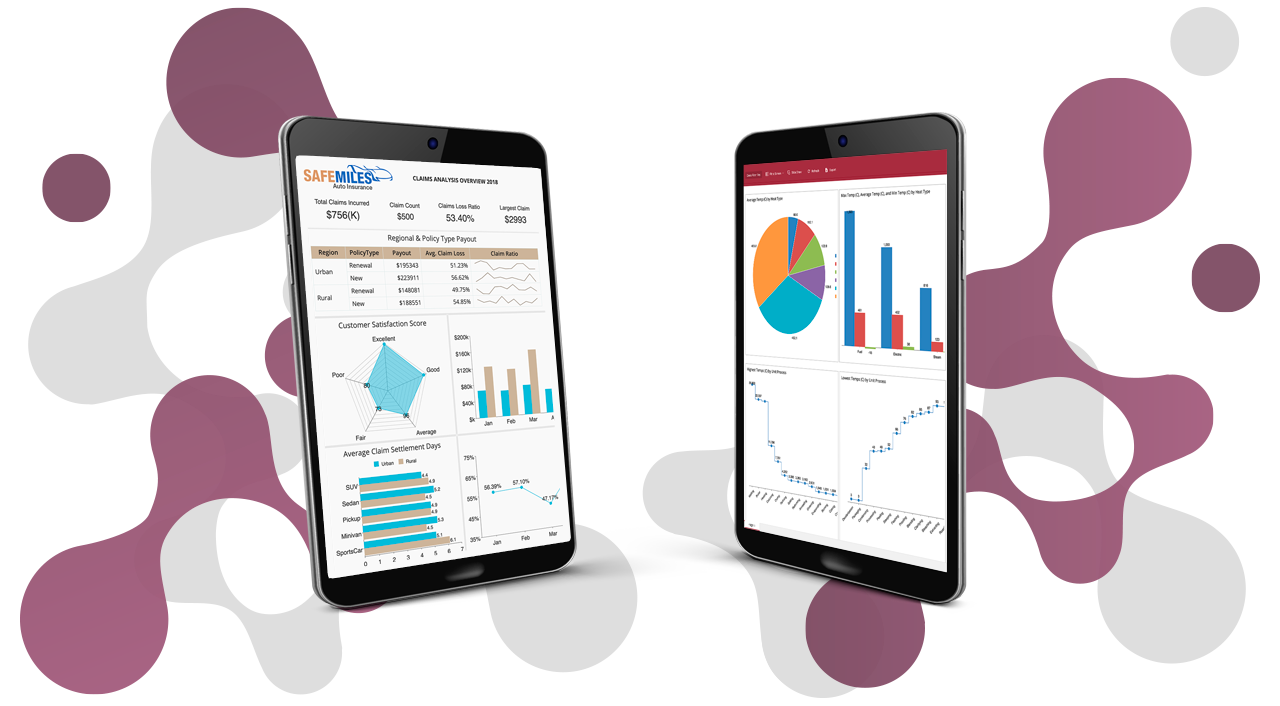With the increasing trend in enterprises becoming data-driven, business intelligence is becoming more integrated into business processes and is more vital to the success of an enterprise now more than ever before.
Recent studies state that 90% of the world's total data was generated within the last two years. This has plunged many organizations into an information overload, consequently, the need to have more intelligent, intuitive means of analyzing and interpreting data is needed now more than ever.
Many organizations still operate with data silos, such as isolated spreadsheets. When data silos exist, so do multiple versions of the truth, leading to inaccurate intelligence or insights.
With this trend showing no signs of slowing down, it may be time your organization investigates investing in a business intelligence solution. Regardless of the industry, your company is in, there is an excess of business intelligence solutions at your fingertips.
Business intelligence tools are essential for the success of all business sizes—from enterprise to small and medium-sized businesses (SMBs). When evaluating and comparing the myriad number of options, it is critical to keep several things in mind.
Here, we'll discuss the top 6 features to look for in a business intelligence solution for your company.
-
Compatibility
-
UI and UX
-
Self-service BI features
-
Embeddability
-
White-labeling
-
Affordability
1. Data Connectors & Compatibility
Is the Business Intelligence Solution Compatible with Your Data?
This first point may seem obvious; however, it surprising how limiting some business intelligence solutions can be with the data sources they support. Moreover, with the rise in data’s role in day-to-day business operations, there are more data sources increasing in popularity.
Considering whether the business intelligence solution is compatible with your data is really a matter of individual use-case.
- If you want your BI solution to plug directly into your CRM through an integrated connector, then your options would be more limited than if you are simply bringing in data from more common data sources such as SQL Server or XML files.
- If your data is stored in a Relational Database Management System (RDBMS), then you need to ensure the BI tool will support this - look for support for Oracle, SQL Server, MySQL, Postgres, SQLite, etc.
- If your data is file-based, then look for Excel, JSON, CSV, and XML support. RDBMS and file-based data storage seem to be popular in today’s data climate, but we may see trends indicating otherwise in the near future. As data becomes bigger, bulkier, and harder to manage, the demand for storing this data will increase, so it may be worthwhile to look for a business intelligence solution that supports data sources that can host big data, such as Hadoop.
This point about data compatibility, like the other points that follow in this blog, is really all about the use case.
Know what data connectors you need to ensure the business intelligence tool you are evaluating supports them!
2. UI & UX
When evaluating such a solution for your organization, take a look at the UI and consider the following:
- Does it look familiar to other applications your end-users are used to interacting with?
- Is everything the user needs to best utilize the tool easy to access?
- Is the layout across different pages consistent, clean, and easy to understand?
- Is the color scheme easy on the eyes? If not, can you change it?
Consider the UX of your Analytics Platform
The UX of the solution is also important to consider, as it lies very closely with the UI.
Take into consideration the following points when it comes to the business intelligence solution’s UX:
- Is it clear what process the end-user needs to follow to utilize all features of the tool?
- Is this user process logical, or will it confuse the average end-user?
- Does the product place more importance on ease of use rather than how aesthetically pleasing it is? - Are there any barriers that may block or prolong user actions, or otherwise confuse the end-user?
Both UI and UX are critical when evaluating a business intelligence solution. While a fresh, clean, and clear UI are important, it is even more essential that the tool has a natural UX that won’t confuse end-users.
Even more critical than both UI and UX is the final result of using the tool, at the end of the day, will it allow end-users to create the business intelligence reports and dashboards that will help drive the success of the organization?
3. Self-service BI Features
Is the Designer User-Friendly?
What good is a robust business intelligence tool if your end-users cannot utilize it to create ad hoc reports and dashboards?
One of the most important things to take into consideration is your end-user audience who will be creating BI reports and interactive dashboards with this solution. Are they technical power users, non-technical business users, or a mix of both?
Self-service business intelligence is a feature that provides data insights to every employee—even if they don't have a background in BI. Self-service empowers every end-user (technical and non-technical) to drill down on data and answer business questions quickly and easily. The user-friendly UI/UX of self-service BI allows the everyday user to become data-driven.
Self-service BI empowers users to perform queries and generate their own reports and dashboards. Business users can easily analyze their data and build ad hoc reports, for coding or assistance from IT.

Retail Analysis BI Dashboard | Wyn Enterprise
4. Embeddability
Is the Business Intelligence Solution Embeddable?
Embedded BI tools can be integrated into existing applications and portals. There are many benefits of embedded BI; end-users can easily visualize, analyze, and communicate the data that is fundamental to their role without logging in to another application.
Whether embedding the BI solution in an application for internal enterprise use or embedding it in a SaaS solution, it is vital that the solution be easily embeddable.
It’s important for a solution to be easily embeddable for multiple reasons.
- Firstly, you don’t want your developers spending any more time than necessary working on integrating a solution within your application. This is one of the key benefits of using an external BI tool vs building your own in-house BI tool.
- Next, embedding the solution typically allows for single sign-on in your application, so end-users have a seamless experience when navigating from your application to the embedded business intelligence solution. This is vital to the end-user experience because you do not want the end-user to have to leave your application for any reason- everything that they need to do should be able to be done without leaving the application.
With all of this in mind, it is up to you to decide if embedding the solution falls under your requirements - if it does not, you will have an easy time finding a stand-alone visual business intelligence tool.
If being embeddable is a requirement of yours, then you will want to spend some time looking at the documentation, SDKs, API, and other resources for each product being evaluated to understand any challenges you may face when looking to embed the solution into your application. This may require a substantial time commitment during the evaluation phase, but it will be worth the payoff later down the road when you are able to easily embed and integrate the business intelligence tool into your application.
4. White-Labeling
Is the Business Intelligence Solution Customizable?
I wanted to include this point because many business intelligence solutions in today’s market do not support extensive customization.
If you are embedding this solution within your application, it should be on your list of requirements that the BI tool support white-labeling.
If you are embedding a business intelligence solution within your application, it’s imperative that you check if the solution supports the many aspects of white-labeling.
First, take a look at color schemes. If red is the primary color in your organization’s or app’s color scheme, then you need to be able to customize the embedded solution to match the same color red so that your app maintains a feeling of immersion when users navigate from the application’s home page to the business intelligence section, where your tool is embedded.
Arguably even more important than the color scheme when it comes to white-labeling is the ability to change logos used throughout the solution.
No matter what BI tool you choose, it will have its own logo displayed throughout the UI. You’ll want to change these logos to match your app’s logo or your organization’s logo so that end-users are not aware they are using third-party software. A highly customizable solution will offer your own custom logos for a login screen, page header logo, mobile logo, and favicon.
Advanced white-labeling as described above should be a requirement for anyone looking to embed the business intelligence solution into their application. If part of your application does not fit in with the rest of the application, then the end-user will sense a disconnect and the overarching user experience will not be as exceptional as it would be with a solution that can match your own look and feel.
6. Affordability
Is the Business Intelligence Solution Within Your Budget?
The final point I will cover in this list is arguably the most important for you to consider when evaluating visual business intelligence solutions.
Budgetary constraints are one of the top driving factors in settling on a BI tool. In a situation where your budget cannot afford the perfect BI tool, you will need to prioritize each solution’s features and capabilities and take into consideration the licensing and pricing aspects of each product.
When it comes to finding the right business intelligence tool, you will need to factor in how the solution is licensed.
There are typically two different options when it comes to a license: annual subscription-based, or perpetual.
The former is typically a less expensive up-front cost, but remains the same cost year over year, or, in some cases, can even increase after a certain number of years.
For large enterprises with a reliable and consistent revenue stream, annual licensing should not be a turn-off. However, for start-ups and smaller organizations, annual licensing may seem intimidating, as it should.
If you have a down year and cannot fit the product’s annual fee in your budget, you risk losing the product’s functionality in your application. On the other hand, perpetual licenses will typically cost significantly more up-front, but significantly less year over year.
With a perpetual license, you only need to worry about the initial purchase- any fees after that (annual or otherwise) should only be an optional add-on since the license is perpetual.
Some BI solutions will have both licensing options available, but most will only be one or the other. As with most other items listed in this blog, the type of license to go with is fairly subjective, but it is wise to thoroughly research the licensing models before making a final decision.
The other critical factor when it comes to finding a solution within your budget is user-based fees. Solutions with concurrent user limits are generally not sustainable because it will cost you more to scale up the number of end-users accessing the solution.
You should always look for solutions with no concurrent user limits or user-based fees so that you can continue growing the number of end-users using your application without additional costs.
Look into the total cost of ownership (TCO) and how it will influence pricing.
Explore BI solutions that offer server-based licensing. With server-based licensing, as your application scales and you add users, your licensing fees remain consistent.
Server-based licensing allows for predictable annual budgeting with no hidden fees.
How to Reduce Your Total Cost of Ownership
A company’s BI TCO is low when they have 50 users, but what will it be when they have 251 users?
In this guide, we discuss factors that impact TCO and several strategies to reduce your BI costs.
User-based vs. Sever-based Licensing
Understand Your Total Cost of Ownership
The other critical factor when it comes to finding a solution within your budget is user-based fees. Solutions with concurrent user limits are generally not sustainable because it will cost you more to scale up the number of end-users accessing the solution.
You should always look for solutions with no concurrent user limits or user-based fees so that you can continue growing the number of end-users using your application without additional costs.
Look into the total cost of ownership (TCO) and how it will influence pricing.
A company's total cost of ownership (TCO) is a term used to describe how much it costs to acquire, operate, and maintain something over the course of its lifetime. Other than the initial price, TCO includes other expenses that may be hidden beneath the surface. If you are looking for BI solutions, here is a great article that helps your accurately budget for BI, year over year.
Explore BI solutions that offer server-based licensing. With server-based licensing, as your application scales and you add users, your licensing fees remain consistent. Server-based licensing allows for predictable annual budgeting with no hidden fees.
Understand the Story Behind Your Data
Wyn is a web-based BI and data analytics platform that provides greater insight into your data.
Wyn offers built-in tools for report and dashboard creation, data governance, security integration, embedded BI, automated document distribution, and a business-user-friendly interface for self-service business intelligence.






























